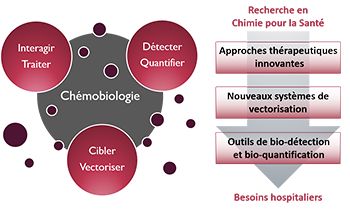Article
- Projet
-
-
Aline THOMAS,
- Titre
-
Probing the acceptor active site organization of the human recombinant β1,4-galactosyltransferase 7 and design of xyloside-based inhibitors.
-
[Full paper
 ]
]
- Auteurs
- Saliba M, Ramalanjaona N, Gulberti S, Bertin-Jung I, Thomas A, Dahbi S, Lopin-Bon C, Jacquinet JC, Breton C, Ouzzine M, Fournel-Gigleux S
- Edition
- J. Biol. Chem. 290, 7658-70
- Année
- 2015
- Résumé
- Among glycosaminoglycan (GAG) biosynthetic enzymes, the human β1,4-galactosyltransferase 7 (hβ4GalT7) is characterized by its unique capacity to take over xyloside derivatives linked to a hydrophobic aglycone as substrates and/or inhibitors. This glycosyltransferase is thus a prime target for the development of regulators of GAG synthesis in therapeutics. Here, we report the structure-guided design of hβ4GalT7 inhibitors. By combining molecular modeling, in vitro mutagenesis, and kinetic measurements, and in cellulo analysis of GAG anabolism and decorin glycosylation, we mapped the organization of the acceptor binding pocket, in complex with 4-methylumbelliferone-xylopyranoside as prototype substrate. We show that its organization is governed, on one side, by three tyrosine residues, Tyr(194), Tyr(196), and Tyr(199), which create a hydrophobic environment and provide stacking interactions with both xylopyranoside and aglycone rings. On the opposite side, a hydrogen-bond network is established between the charged amino acids Asp(228), Asp(229), and Arg(226), and the hydroxyl groups of xylose. We identified two key structural features, i.e. the strategic position of Tyr(194) forming stacking interactions with the aglycone, and the hydrogen bond between the His(195) nitrogen backbone and the carbonyl group of the coumarinyl molecule to develop a tight binder of hβ4GalT7. This led to the synthesis of 4-deoxy-4-fluoroxylose linked to 4-methylumbelliferone that inhibited hβ4GalT7 activity in vitro with a Ki 10 times lower than the Km value and efficiently impaired GAG synthesis in a cell assay. This study provides a valuable probe for the investigation of GAG biology and opens avenues toward the development of bioactive compounds to correct GAG synthesis disorders implicated in different types of malignancies







 ]
] 



 Annuaire
Annuaire Contact
Contact Plan d'accès
Plan d'accès ENG
ENG Login
Login


